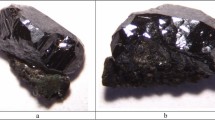Summary and conclusion
An optically positive cordierite from the khondalites in Pachipenta of Vizagapatam District was chemically analysed and its optical properties determined. It has a hardness of 7·5 and Sp. Gr. 2·71 and its 2V as determined by Fedorov’s Stage is 74°. In contrast to the negative optical sign of a normal cordierite, this cordierite gives a positive optical sign. The tentative suggestion put forward by Krishnan and others that the optically positive character of cordierites is probably due to the ratio of MgO to FeO does not find support from the present studies. As shown by Winchell it appears that there is no close correspondence between chemical composition and optical characters in cordierites. The possibilities of traces of alkalies contributing to the change in optical sign as suggested by Folinsbee, is worth consideration but must await the availability of analyses giving these constituents.
Similar content being viewed by others
References
Chacko, I. C. “Optically positive cordierite,”Geol. Mag., 1916,53, 462–64.
Conant, L. C. “Optically positive cordierite from New Hampshire,”Am. Min., 1935,20, 310.
Dana, E. S.Text-book of Mineralogy, 1922, 497.
Folinsbee, R. E. “Optic properties of cordierite in relation to alkalies in the cordierite—Beryl structure,”Am. Min., 1941,26, 485–500.
Iyer, L. A. N. “A study of the Calc gneisses, scapolite gneisses and cordieritegarnet-sillimanite rocks of Madras,”Mineral Mag., 1929,22, 121–35.
Krishnan, M. S. “Note on Cordierite in a Cordierite gneiss from Madura District, Madras, India,”ibid., 1924,20, 248–51.
Mahadevan, C. “Pleochroic Haloes in Cordierite,”Ind. Jour. Phys., 1927,1, Pt. IV, 447.
Middlemiss, C. S. “Note on a sapphirine bearing rock from Vizagapatam District,”Rec. G. S. I.,21, Pt. I, 38–42.
Rutherford, R. L. “Optically positive cordierite from the North-West Territories,”Canada, Am. Min. 1933,18, 216.
— “Optically positive cordierite in the Kisseyenew gneiss at Sherridon, Manitoba,”ibid., 1936,21, 386–88.
Walker, T. L. “A geological sketch of the eastern portion of the Jeypore Zamindari, Vizagapatam district,”G. S. I. Gen. Report, 1899–1900.
Walker, T. L. and Collins, W. H. “Petrological study of some rocks from the Hill tracts, Vizagapatam District, Madras Presidency,”Rec. G. S. I.,36, Pt. 1, 18.
Winchell, A. N. “Cordierite,”Am. Min., 1937,22, 1175–79.
Author information
Authors and Affiliations
Rights and permissions
About this article
Cite this article
Mahadevan, C., Sastry, G. Optically positive cordierite from the khondalites of Pachipenta, Vizagapatam District. Proc. Indian Acad. Sci. 27, 361 (1948). https://doi.org/10.1007/BF03171028
Received:
DOI: https://doi.org/10.1007/BF03171028




